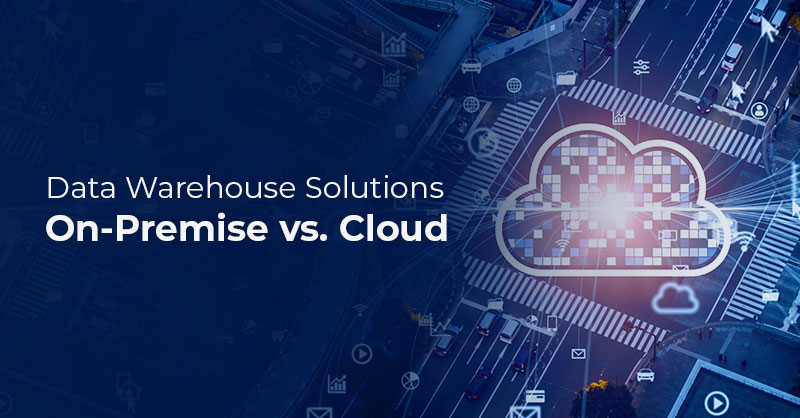Data Warehouse Solutions—On-Premise vs. Cloud

Written by Imran Abdul Rauf
Technical Content Writer
December 8, 2021
Organizations require a data warehouse to deliver actionable business intelligence and conduct data analysis. But should your business create a data warehouse on-premises, or on cloud?
Although the increasing adoption of IoT technologies and cloud data usage for computing for different tools has pushed the cloud data warehouse market to reach a worth of $39.1 billion by 2026, but the comparison varies depending on important aspects like scalability, cost, deployment, speed, connectivity, reliability, and security.
What is On-Premise?
On-premises solutions require high upfront costs as the team spends invests in all the needed hardware and software licenses. Moreover, the right talent is needed, like a consultant who’ll assist the team with installation and ongoing support.
One of the major benefits that tempts IT team to use on-premises warehouse is that they have complete control over the entire repository, and they can also see how and when data navigates through the network.
What is a Cloud Data Warehouse?
A database stored, or a managed service in a public cloud environment which is optimized for scalable analytics and BI. Enterprise data warehousing has been an important component for business analytics and reporting purposes for many years now. However, they weren’t created with the capacity to handle the huge bulks of data produced by businesses on daily basis and the rapidly changing consumers’ needs and usage preferences.
Through cloud data warehousing, IT teams are no longer confined by physical data centers and now users have the liberty to alter DWS for catering different project, business requirements.
Cloud vs. On-Premise
Cloud based solutions have the upper hand over on-premise warehouses as the right choice for businesses today. The preference is mainly due to the shared pool of compute resources that offer flexibility through every shape, form, and scale.
However, on-premise warehouses still have their own share of faithful users with ample reasons such as data security, compliance concerns, low cost for optimization, and so on. Both the approaches use different use cases, so how to decide which is the right one for your business? These are the main areas to consider.
Deployment
The most noticeable difference is how both on-premise and cloud data warehouses are deployed. The softwares for on-premise are installed locally, or only on the company’s proprietary systems and servers.
Whereas, cloud based can either be hosted in a public or private cloud. Organizations who choose public cloud opt to deploy their resources and data at third party providers, which means providing access to other public networks. And choosing private cloud is using resources as per the requirements of the business and also allowing limited access.
Scalability
As organizations and their business units and workforce grow, the need for bigger data warehouses grow in a proportionate manner. Hence, this requires IT teams to expand the data storage capacity regularly. On-premise data warehouses require physical additions of storage hardware, and if you need to scale down, you’ll be required to remove unwanted hard drives.
In cloud data warehouses, you can scale up or down as per the subscription packages, the tier will allocate as much space as you demand. There is no further need to make configuration changes, still the annual costs will likely increase accordingly.
Cost
Cloud data warehouses frees you from most costs incurred on upfront basis. You only pay for the resources your business and teams utilize, which consequently improves efficiency and saves expenses. Costing is one major reason why enterprises worldwide are shifting towards cloud warehouses. This pay-as-you-go approach doesn’t mandate teams to pay for idle machines, and the cloud storage provider is responsible for covering the maintenance, administration, and updates costs.
According to Global Market Insights, the high popularity and adoption of cloud providers and big data analytics, and powerful ICT infrastructures in the North America’s data warehousing sector is expected to acquire a share of over 40% by 2025 in the global industry.
Speed
If your entire organization is at a single physical location, then on-premise DWS is always going to be quicker. And cloud solutions could add a certain degree of latency in your data transactions as the DWS are outside your local network, so any particular request will occur at the same speed as other transactions over the internet.
But cloud providers are the best solution when it comes to organizations with multiple locations. Cloud servers resides in different locations throughout the globe, and when smart routing systems tend to optimize your queries or requests, the data travels through the fastest server located in your particular area.
As remote working is the new norm and businesses require data transaction to happen promptly, cloud DWS is the right option. Fortunately, 5G enables higher data transfer speeds and near zero latency.
Connectivity
Data warehouses primarily function to acquire data from different systems, hence, need seamless connectivity to travel to and from those systems. Cloud DWS are comparatively easier to connect with other cloud resources. Most resources allow users to acquire data, store in the respective systems, and access whenever needed. Take cloud ETL for example, users can leverage the tools to integrate a large number of different data sources based on readymade connectors, and further transform and use data for analytics purposes.
While on-premise DWS allow companies to exercise complete control over security, the dynamics of different applications, and other connectivity or access problems. Government and banking sectors prefer on-premise DWS where similar limitations are critical to their operations.
Reliability
Cloud availability and reliability are one of the major concerns for IT infrastructures at an organization level. Fortunately, cloud DWS assure Service Level Agreements that offers a defined level of software availability.
For example, Google guarantees a monthly uptime percentage of 99.9% for cloud storage and BigQuery. And notable cloud platform providers like Royal Cyber will duplicate your data across multiple clusters to make sure optimum reliability is attained. While on-premise DWS have to invest in authentic hardware equipment with a 24/7 available support team on board.
Security
When use cases are involved, cloud data warehouses are generally more secure than their on-premise counterparts. It might seem contrary to a common belief that cloud solutions send information to third party platforms as compared to on-premise DWS keeping everything within the company’s network. In reality, data doesn’t stay in your office building. For example, relevant stakeholders often need to access and transfer data to external partners like legal teams, accounting and audit consultants, and likewise.
Cloud based solutions prioritize a security-first approach, especially related to data centric transactions. For instance, Google BigQuery is a full-fledged, serverless data warehouse that allows employees to remotely access data through a secure, approved channel.
The Best Cloud Data Warehouse Options
Data warehousing solutions mostly come with a range of features useful for storage, data management, and consolidation, which can acquire and curate data from different environments, transform data and find and remove duplications, and assure consistency in met in the analytics.
And when delivered through cloud, IT teams have even more flexibility. But what are the best cloud DWS service providers in the business that could best suit your business needs?
Azure Synapse
Synapse integrates data from thousands of sources across the organization’s departments and subsidiaries to perform analytics querying. In addition, the tool allows users to report management across all levels, from supervisors and managers to C-suites execs and directors, and protect authorization through data access control.
Snowflake
Snowflake is a SaaS-based, cloud-agnostic platform that helps teams allocate compute resources of various cloud vendors to the same database for loading and querying purposes.
Amazon Redshift
Amazon Redshift is a data warehouse platform that enables SQL-querying of exabytes of structured, semi-structured, and unstructured data. The practice is done throughout the operational data stores, data warehouse, and data lake to further collect data with big data analytics and machine learning operations.
Google BigQuery
BigQuery is a cost-effective, multi-cloud which enables users to perform scalable analysis over petabytes of data. The platform is most beneficial when core analytics queries to filter data as per partitioning or clustering or require the entire dataset’s scanning.
SAP Data Warehouse Cloud
SAP Data Warehouse Cloud integrates data and cloud through a multi-cloud solution including data warehouse, data integration, and analytics features for a data-based enterprise. The platform connects data across on-premise and multi-cloud repositories in real-time while securing business context.
Deciding Between On-Premise and Cloud DWS
Most companies opt for cloud data warehouse services due to the benefits it offers such as cost effectiveness, easy and quick setup, promptly scalable and accessible, and easy to use.
In addition to that, delegating the maintenance and management of data warehouse to a third party platform will free ample time and resources for team to focus on other important tasks like analytics and decision making. Or companies can also go for a hybrid cloud solution where data services are merged with their local IT infrastructures.
How Royal Cyber Works?
Royal Cyber is a digital transformation company helping businesses leverage valuable insights from their data in real time. We have partnered with Splunk, Databricks, Informatica, and other data warehousing platforms with the objective to help companies make smart, informed decisions through custom big data analytics.
Contact us to get a free consultation through our experienced data analytics team and learn how quality data insights can help you enhance productivity, boost collaboration, and plan and manage resources on board.
Recent Blogs
- An Insight into ServiceNow Hardware Asset Management (HAM) Ramya Priya Balasubramanian Practice Head Service Now …Read More »
- Learn to write effective test cases. Master best practices, templates, and tips to enhance software …Read More »
- In today’s fast-paced digital landscape, seamless data integration is crucial for businessRead More »



